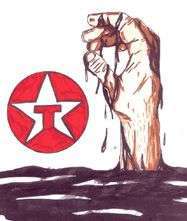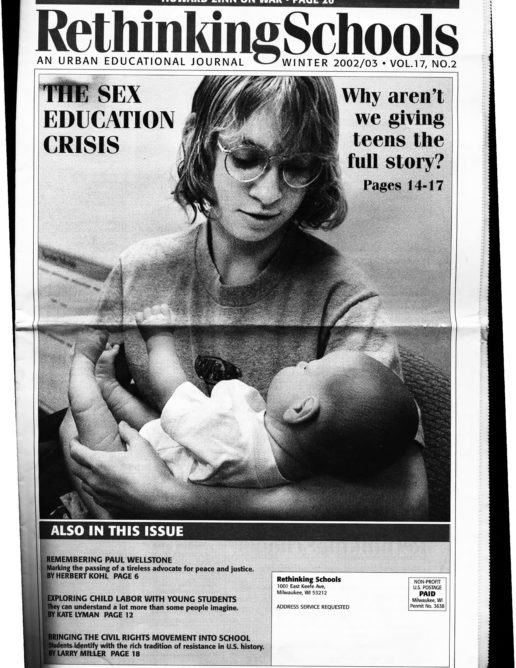Rethinking Globalization
Thinking in pictures
Illustrator: Danny Popovici, Nick Cook

“Mark” was a student in my Global Studies class several years ago. I would often see him carting his oversized skateboard through the halls, his longish black hair falling in his eyes. His writing could be hard to decipher. In parent conferences, his mother warned me that Mark didn’t much care for academic classes and confided that Mark had a head injury when he was a child, and perhaps because of this, was slower than other students – which is a reason I treasure a copy of the metaphorical drawing that Mark completed at the end of our unit on development vs. indigenous cultures.
In the unit, we study the arrival of “progress” in the Buddhist enclave of Ladakh high in the Himalayas, watching the video Ancient Futures, and reading excerpts from Helena Norberg- Hodge’s book of the same title. We examine the impact of TV on the Inuit and Dene people in northern Canada. And we conclude the unit with an examination of the ravages of oil drilling on indigenous groups like the Cofan and Huaorani in Ecuador’s Oriente rainforests. The unit is a hard-hitting portrayal of some of the devastating consequences of “development” around the world.*
Near the end of the unit I ask students to create a metaphorical drawing illustrating any aspect of the collision between development and indigenous cultures that made an impression on them. In their drawings, students might choose one narrow aspect, like the effect of oil in Ecuador, or try to depict the entire “development” process. I ask them to explain their illustration on the back. I also emphasize that I’m not looking for a great work of art, rather it’s the imagination and ideas I’m interested in.

At first, I couldn’t figure out what Mark had drawn. There were wild hunks of black and red and yellow thrown helter skelter about the page, with a box in the center enclosing more blacks, reds, and yellows. But then I realized that the lines protruding from the top of the box were the rabbit ears of an antenna. The box was a television. On the back of the drawing, Mark had written: “The bottom is the oil. The image on tv is the world, and the world and oil/tv is on fire. The oil and tv are destroying the earth and the only thing we will have left are images of the earth on tv.”
Never in a million years could I have come up with such a profound drawing. And this highlights an important dimension of the assignment: It levels the academic playing field, in that it pulls students out of the realm of words and into one of pictures – a realm that may offer success to students who are not traditional academic achievers. It’s an assignment in which these students can demonstrate their grasp of concepts without having to simultaneously navigate the conventions of the essay.
I assign the metaphorical drawing immediately preceding the end-of-unit essay, which, similarly, allows students to write on any aspect of development that moves them. The metaphor assignment prompts students to think in pictures, and tends to encourage them to imagine complex interrelationships – ones that they may end up tackling in their essays, but that are more easily explored initially without having to put into words. In fact, students sometimes find that without much effort they can turn their metaphorical drawings into thesis statements for their essays.
Paul’s drawing depicts a store called “Western Front,” loaded with consumer goods in the window. In the back alley is garbage, a burning barrel of oil, and a bewildered looking man. Paul writes:
Western Front is the civilization store. On the outside it looks inviting to primitive cultures, but what people don’t see is the back alley where they will end up lost and confused and in poverty. Uncle Sam is on the TV in the display window because TV is his ultimate weapon. It makes people feel insecure so they buy consumer goods and help Uncle Sam’s economy.
Because we end the unit looking at the consequences of oil drilling in rainforests, lots of students take this as the starting point for their drawings. Raul’s illustration shows a strong arm labeled “oil companies” and a hand squeezing the earth that is dripping oil. This year, Lindy’s was one of the most complex and startling. Titled “CIVILIZATION,” a faceless man with a spear stands in the foreground. (This is not mere stereotype; Huaorani Indians still use spears.) A tree with flaming money is beside him and a black road leads up a mountain to a city filled with skyscrapers. Lindy writes:
The river of oil is feeding the tree that grows money. The money is burning to symbolize the deception the Huaorani fell into. The Huaorani never saw the money. All they saw was the devastation of the environment and their culture. “Civilization” is not as pretty as they might have thought. The oil is also the road to development. The developed civilization lives at the top of the mountain raining down pollution on those “uncivilized.” The Huaorani man is drawn with little detail. This shows the lack of care for the Huaorani as individuals or as a whole culture. The Huaorani man is connected to the tree and to the spear. The man is turning the color of the poisoned tree. The sky is white, the future is unpredictable.
There was a pattern in students’ drawings that was hard to ignore. Almost all of them were devoid of hope, although Lindy’s does suggest a future still to be written. Sadly, they were also mostly devoid of struggle. That’s an additional benefit of assigning metaphorical drawings: They help us take a snapshot of the broad concepts that students are grasping – or perhaps not grasping – from our teaching. My classes had spent time talking and writing about the remarkable ecological and social achievements of the Ladakhi people, and we’d watched a video, Local Futures, about efforts of Westernbased environmental activists to work with Ladakhis to preserve Ladakhi culture. Similarly, we’d seen a video and read about the Huaoranis’ encyclopedic knowledge of the forest, and also examined their efforts to resist the appropriation of their land by the Ecuadorian government and the oil companies. Still, none of these made the same kind of impression as did the many faces of cultural erosion initiated by Western forces of “development.”
It’s early in the year, and students’ anger toward greed-powered developers of various stripes is a good place to start. But it wouldn’t be a good place to end. Students also need to consider the countless ways that people are working for global justice. Metaphorical drawings invite students to picture aspects of the world that exists. We might also encourage them to picture aspects of the world that could be.
*These lessons are described more fully in several articles in Rethinking Globalization: Teaching for Justice in an Unjust World . See “Oil, Rainforests, and Indigenous Cultures” (p. 268), “TV and the Cloning of Culture” (p. 292), and “Rethinking Primitive Cultures: Ancient Futures and Learning from Ladakh” (p. 308).

